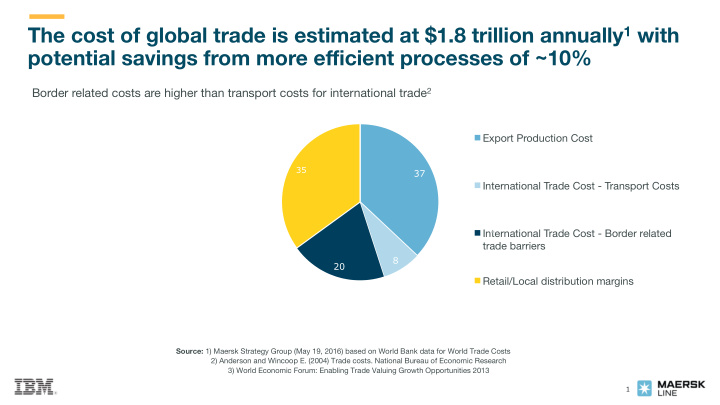



The cost of global trade is estimated at $1.8 trillion annually 1 with potential savings from more efficient processes of ~10% Border related costs are higher than transport costs for international trade 2 Export Production Cost 35 37 International Trade Cost - Transport Costs 4,7% 14,5 International Trade Cost - Border related % trade barriers 8 20 Retail/Local distribution margins Source: 1) Maersk Strategy Group (May 19, 2016) based on World Bank data for World Trade Costs 2) Anderson and Wincoop E. (2004) Trade costs. National Bureau of Economic Research 3) World Economic Forum: Enabling Trade Valuing Growth Opportunities 2013 1
The case for a better way TODAY TOMORROW Authority Consignee The Platform Exporter Authority Authority Forwarder Rail Forwarder Consigne e Exporter Trucker Authority Carrier Terminal Authority Terminal Authority Carrier Authority Inconsistent information across organizational boundaries and “blind spots” Instant, secure access to end-to-end supply chain information; single § § throughout the supply chain hinder the efficient flow of goods source of the truth Complex, cumbersome, and costly peer-to-peer messaging Assurance of the authenticity and immutability of digital documents; trusted § § cross-organizational workflows Manual, time-consuming, paper-based processes; high air courier expense § and delays Better risk assessments and fewer unnecessary interventions § Risk assessments often lack sufficient information; clearance processes Far lower administrative expenses and elimination of costs to move physical § § subject to fraud paper across international borders The administrative cost of handling a container shipment is comparable to Estimated global savings from more efficient sharing of information: $27 § § the cost of the actual physical transport billion 2
Reducing global trade barriers and increasing efficiency across international supply chains The Platform will come with two launch products Transportation Ocean Management. Carriers Shippers / Supply Chain Actors Shipping Information Pipeline (SIP) 1 Customs Supply Chain Systems Visibility Will provide end-to-end supply chain visibility that Systems enables all actors involved in a global shipping transaction to securely and seamlessly exchange shipment events in real time Platform Ports and Trade Associations Terminals Paperless Trade 2 Supply Chain / Logistic actors Will digitize and automate paperwork filings for the Transportation internal Management systems systems import and export of goods by enabling end users to securely submit, stamp and approve documents across national and organizational boundaries Port Community Systems; Terminal Operating Systems Authorities Freight Forwarders The Platform will be built on an open technology stack and is underpinned by Blockchain technology 3
This will be an industry platform that connects and provides benefits to the supply chain ecosystem This is not just a product offering; it will also be a global network of interconnected shipping corridors linking the ports and terminals, customs authorities, shipping lines, 3PLs, inland transportation, shippers, and other actors Provide information about the disposition of shipments within the boundaries of the port / terminal Ports and Benefit from pre-built connections to shipping lines and other actors, end-to-end visibility across shipping corridors, and real-time Terminals access to more information to enrich port collaboration and improve terminal planning Provide information about the disposition of shipments across the ocean leg Shipping Lines Benefit from pre-built connections to customers and ports / terminals around the world and real-time access to end-to-end supply chain events Provide information about the export and import clearance status for shipments into and out of the country Customs Benefit from more informed risk assessments, better information sharing, less manual paperwork, and easier connections to national Authorities single window platforms Provide t he transportation plan, inland transportation events, information on intermodal handoffs, and document filings Freight Benefit from pre-built connections to the ecosystem, improved tools for customs clearance brokerage function, and real-time access to Forwarders / 3PL the end–to-end supply chain data to improve effectiveness of track-and-trace tools Provide information on the disposition of shipments carried on trucks, rail, barges, etc. Intermodal Benefit from improved planning and utilization of assets (e.g., less queuing) given real-time access to end-to-end supply chain events for Transport shipments Engage with GTD as a customer and user of SIP and Paperless Trade Shippers Benefit from a streamlined and improved supply chain allowing for greater predictability, early notification of issues, full transparency to validate fees and surcharges, and less safety stock inventory 4
Recommend
More recommend